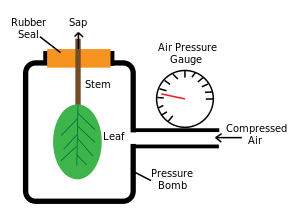Pressure bomb
Not to be confused with Pressure cooker bomb.

A diagram showing the setup of a Pressure bomb
A pressure bomb or pressure chamber or Scholander bomb is an instrument with which it is possible to measure the approximate water potential of plant tissues. A leaf attached to a stem is placed inside a sealed chamber and pressurised gas is added to the chamber slowly. As the pressure increases at some point sap will be forced out of the xylem and will be visible at the cut end of the stem. The pressure that is required to do so is equal and opposite to the water potential of the leaf.[1][2] Pressure bombs are very durable and mechanically simple,[3] which make them a popular alternative to traditional pressure sensors for taking field measurements.
References
- ↑ http://jxb.oxfordjournals.org/cgi/content/abstract/23/1/267 1972 Journal of Experimental Botany - The Measurement of the Turgor Pressure and the Water Relations of Plants by the Pressure-bomb Technique M. T. TYREE and H. T. HAMMEL
- ↑ Scholander, P.; Bradstreet, E.; Hemmingsen, E.; Hammel, H. (1965). "Sap Pressure in Vascular Plants: Negative hydrostatic pressure can be measured in plants". Science. 148 (3668): 339–346. Bibcode:1965Sci...148..339S. doi:10.1126/science.148.3668.339. PMID 17832103.
- ↑ Gifftord, H.H. (18 August 1971). "SIMPLIFIED APPARATUS FOR DETERMINING LEAF WATER POTENTIALS IN PINE NEEDLES" (PDF). Scion Research.
Further reading
This article is issued from Wikipedia - version of the 7/28/2016. The text is available under the Creative Commons Attribution/Share Alike but additional terms may apply for the media files.